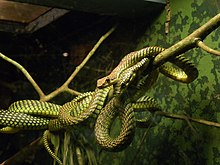Chrysopelea paradisi
| Paradise flying snake | |
|---|---|
 | |
| Scientific classification | |
| Domain: | Eukaryota |
| Kingdom: | Animalia |
| Phylum: | Chordata |
| Class: | Reptilia |
| Order: | Squamata |
| Suborder: | Serpentes |
| Family: | Colubridae |
| Subfamily: | Ahaetuliinae |
| Genus: | Chrysopelea |
| Species: | C. paradisi |
| Binomial name | |
| Chrysopelea paradisi Boie, 1827 | |
Paradise tree snake or paradise flying snake (Chrysopelea paradisi) is a species of colubrid snake found in Southeast Asia. It can, like all species of its genus Chrysopelea, glide by stretching the body into a flattened strip using its ribs. It is mostly found in moist forests and can cover a horizontal distance of 10 meters or more[2] in a glide from the top of a tree. Slow motion photography shows an undulation of the snake's body in flight while the head remains relatively stable, suggesting controlled flight. They are mildly venomous with rear fangs and also can constrict their prey, which consists of mostly lizards and bats.

Etymology
[edit]The species name paradisi comes from either the Latin "paradisus" or Greek "paradeisos", which means park. It is assumed that the holotype from 1826 was found in a park.[3]
Taxonomy
[edit]Chrysopelea paradisi belongs to the genus Chrysopelea, which contains four other described species.[4]
Chrysopelea is one of five genera belonging to the vine snake subfamily Ahaetuliinae, of which Chrysopelea is most closely related to Dendrelaphis, as shown in the cladogram below:[5]
| Ahaetuliinae |
| ||||||||||||||||||||||||||||||

Distribution
[edit]It is found in Thailand, Indonesia, Brunei, India, Malaysia, Myanmar, Philippines, and Singapore.[3]
Behavior
[edit]It lives in forests and is fully arboreal, and glides between trees. It has oviparous reproduction.[3]
Gliding
[edit]The flying snake has a unique kinematic that is different compared to other animals with gliding or flight because they are cylindrical and do not have limbs such as legs or wings.[6] Although the flying snake does not display visible characteristics that contribute to its ability to glide, there are three aspects that have been studied and found to have great positive effects on this. Their form of takeoff which is most commonly the anchored J-loop take-off,[7] once airborne their cross sectional body is shaped into a triangle,[8] and their bodies use an aerial undulation to maximize the distance traveled.[9]
References
[edit]- ^ Vogel, G.; Wogan, G.; Diesmos, A.C.; Gonzalez, J.C.; Inger, R.F. (2014). "Chrysopelea paradisi". IUCN Red List of Threatened Species. 2014: e.T183189A1732041. doi:10.2305/IUCN.UK.2014-1.RLTS.T183189A1732041.en. Retrieved 20 November 2021.
- ^ "Here's how flying snakes stay aloft". Science News. 2020-06-29. Retrieved 2021-01-14.
- ^ a b c Chrysopelea paradisi at the Reptarium.cz Reptile Database. Accessed 26 June 2024.
- ^ Genus Chrysopelea at The Reptile Database.
- ^ Mallik, Ashok Kumar; Achyuthan, N. Srikanthan; Ganesh, Sumaithangi R.; Pal, Saunak P.; Vijayakumar, S. P.; Shanker, Kartik (27 July 2019). "Discovery of a deeply divergent new lineage of vine snake (Colubridae: Ahaetuliinae: Proahaetulla gen. nov.) from the southern Western Ghats of Peninsular India with a revised key for Ahaetuliinae". PLOS ONE. 14 (7): e0218851. Bibcode:2019PLoSO..1418851M. doi:10.1371/journal.pone.0218851. ISSN 1932-6203. PMC 6636718. PMID 31314800.
- ^ Socha, J. J. (2011, August 3). Gliding flight in Chrysopelea: Turning a snake into a wing. OUP Academic. Retrieved October 28, 2022, from https://academic.oup.com/icb/article/51/6/969/616152?login=true
- ^ Socha, J. J. (1 September 2006). "Becoming airborne without legs: the kinematics of take-off in a flying snake, Chrysopelea paradisi". Journal of Experimental Biology. 209 (17): 3358–3369. doi:10.1242/jeb.02381. PMID 16916972.
- ^ Holden, D.; Socha, J. J.; Cardwell, N. D.; Vlachos, P. P. (29 January 2014). "Aerodynamics of the flying snake Chrysopelea paradisi: how a bluff body cross-sectional shape contributes to gliding performance". Journal of Experimental Biology. 217 (3): 382–394. doi:10.1242/jeb.090902. PMID 24477611.
- ^ Socha, J. J. (15 May 2005). "A 3-D kinematic analysis of gliding in a flying snake, Chrysopelea paradisi". Journal of Experimental Biology. 208 (10): 1817–1833. doi:10.1242/jeb.01579. PMID 15879063.
Further reading
[edit]- Boie, F. 1827 Bemerkungen über Merrem's Versuch eines Systems der Amphibien, 1. Lieferung: Ophidier. Isis van Oken, Jena, 20: 508–566.
External links
[edit] Data related to Chrysopelea paradisi at Wikispecies
Data related to Chrysopelea paradisi at Wikispecies Media related to Chrysopelea paradisi at Wikimedia Commons
Media related to Chrysopelea paradisi at Wikimedia Commons- Flying snake home page by Jake Socha
- C. paradisi at Thailand Snakes.
- Flying Snake Video w/additional info.
- Research related article Archived 2014-02-21 at the Wayback Machine.


 French
French Deutsch
Deutsch